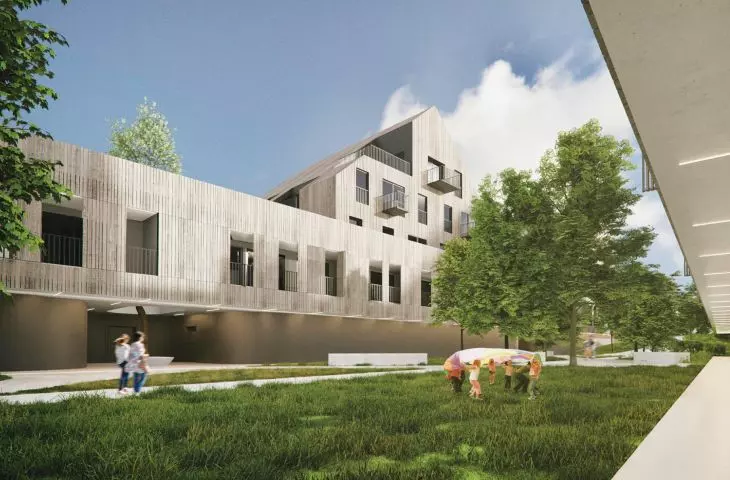"Is it possible to fit 110 apartments in buildings whose scale will be inviting rather than repulsive?" - this was the question posed by architects from BAH Studio when they entered a competition to design a sustainable multi-family housing development on Kosmiczna Street in Katowice. Everything indicates that it can - the concept submitted by Mateusz Białek, Marcin Harnasz, Bartłomiej Tymosiak and Piotr Rutkowski not only realized this assumption, but was also recognized by the jury.
The work was distinguished for its search for a holistic urban-architectural solution resulting from the shape and topography of the plot, as well as for an interesting terraced solution for the space of the tenants' gardens, the competition jury's justification reads.
The architects' starting point was an urban analysis of the surroundings, which made it possible to distinguish two types of urban layouts - a regular one with two- and three-story buildings located along the streets, and an irregular one formed by blockhouses from the 1960s and 1970s. In creating a sustainable TBS housing development in Katowice, the designers took inspiration from both these layouts.
Left: block housing estates from the 1960s and 1970s; right: a regular urban layout with two- and three-story buildings located along streets
© BAH Studio
The multi-story longitudinal buildings with a corridor layout stretching from Radosna Street to Miła Street mark out an axis to which we relate on the principle of counter, negative, by creating a trench - a green valley with the scale of a large-panel block of flats on the extension of the axis, with the target buildings placed on its two sides, the architects explain. - The valley, which is the central part of the housing development, refers to the organic plan of the original design of the Giszowiec workers' housing estate from 1910 and the irregular arrangements of ten-story apartment blocks. The rounded, irregular paths or the inviting entrance area are a result of this. On the other hand, what I find above the ground surface is the result of analyses of regular layouts of two- and three-story buildings harmonizing with the Giszowiec development, they add.
Left: schematic of the estate's layout; single-story blocks with apartments in a corridor layout;
Right: schematic of the estate's layout with six point buildings and a green valley
© BAH Studio
The second important element that influenced the design of the architects from the BAH team was history. The designers drew on the shapes of traditional roofs - gabled, mansard and hipped - and simplified them to give the designed buildings modern forms. They also referred to the wooden fence, recorded in archival photographs, which existed at the site - two longitudinal single-story blocks located on opposite sides of the valley remind us of it. In these low blocks were placed apartments in a corridor arrangement, which can be accessed from the level of the park or directly from the home gardens. Six three-story buildings were located on this structure, three on each side.



projections and types of apartments
© BAH Studio
The architects, wanting to avoid monotony, diversified the blocks with roof shapes, window rhythms, indentations and terraces. The whole is tied together by bright, wooden elevations, symbolically referring to the white houses and shingled roofs of the old Giszowiec architecture.
So was it possible to fit 110 apartments in the inviting buildings? Yes, and even quite a bit more - the combination of long, single-story blocks with six point-blocks allowed the architects to fit 120 apartments in the estate, more than half of which (62) have their own private garden.



cross-sections and types of apartments
© BAH Studio
In order to make the new housing development resident-friendly, the designers limited vehicular traffic on the site, placing entrances to underground parking lots at the entrance to the establishment, and to separate the buildings from the highway running from the east - they planned to plant tall tree species. The heart of the estate is to be the aforementioned green valley, which the architects envisioned as a place for neighborhood gatherings and a space for two service establishments. The designers also thought about a zone for physical activity and recreation for residents of all ages, planning space for a playground and an outdoor gym. The whole project has been adapted to the needs of people with disabilities.











































